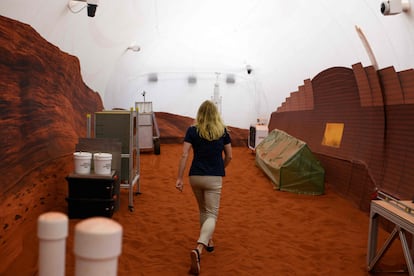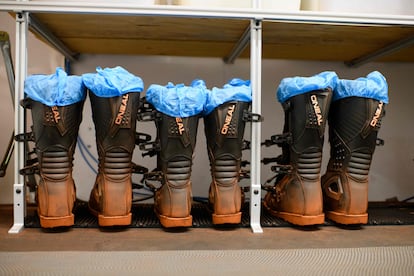Life on Mars, a year in NASA’s simulation of conditions on the red planet
Four volunteers will isolate themselves in a chamber built by the US space agency to recreate the challenges that will be faced by the first manned expeditions


On one side of the hatch lie space helmets, heavy astronaut boots and time management charts. On the other, reddish sand, a whitish sky, and a yellowish light. The mountains of Mars can be seen in the distance. The space base, built with 3D technology, shares this rusty hue, the only shade of color visible on the monochrome horizon: the measuring instruments are also covered with Martian dust. But the mountains are made of cardboard and the vast Martian plain can be covered in around 20 paces: the only long distances here are walked on a gym treadmill while wearing virtual reality goggles. This is not the red planet, although it a perfect simulation of it. It is the environment that NASA has built in one of the hangars at its research center in Houston, where three groups of four carefully selected volunteers — two men and two women — will spend a whole year, starting this summer. They will have no contact with the outside world in order to reproduce as accurately as possible what daily life will be the like for the first human explorers to arrive on Mars.
As part of its preparations for future manned missions, NASA is particularly interested in getting a better idea of the use of available resources and the physical and mental reactions of human beings living in circumstances of extreme pressure and isolation, with a bare minimum of supplies. As the delivery of supplies to Mars will be limited by factors such as volume, mass, and cost, “we can begin to really understand how to support them with what we provide, and that’s going to be very important information to make those critical resource decisions,” says Grace Douglas, head of the CHAPEA (Crew Health and Performance Exploration Analog) program, during a visit to the mocked-up Martian environment.
The enclosure, which is known as Mars Dune Alpha, where the volunteers will spend 12 months of their lives, measures about 160 square meters, of which every inch will be put to good use. “As we move from low Earth orbit, from the Moon to Mars, we’re going to be much more resource-constrained than we are on the International Space Station, and we’re going to be much farther away from Earth or any help that Earth can provide,” Douglas notes. The chamber has been constructed with 3D technology, using materials very similar to those that can be found on the red planet. “It’s one of the technologies we’re examining” for a future station on the planet, Douglas says. Mars Dune Alpha has four bedrooms, one for each resident, a living room with a kitchen — no conventional oven or stove, just a microwave — video games, a television, and board games. One of these is already waiting for them in a nod to their pioneering role: Catan, a multiplayer challenge in which participants must explore and build a new world.

There is also a vertical vegetable garden where crew members will grow some of their food, work stations, a gym and small medical office. Throughout their mission, the “analog astronauts,” as NASA calls them, will undergo weekly medical and psychological checkups to assess their health. Should they find the experience too much for them, or should an emergency arise in their personal lives, they will be free to leave the experiment immediately. Two other applicants have been pre-selected as possible replacements.
The most spectacular area of Mars Dune Alpha is accessed through a doubly compartmentalized space: the outdoor area, which recreates the Martian landscape inside a sealed chamber and where the volunteers will have to undertake a series of missions. CHAPEA crews were chosen among members of the public who met specific requirements: they must be aged over 30 years and in excellent physical and mental health, hold an advanced university degree in science and technology and possess extensive work experience in the field. On this first mission, the analog astronauts will be commanded by Kelly Haston, an endocrinologist specializing in the development of disease models. The flight engineer will be Ross Brockwell, a structural engineer and public works administrator in civilian life, with a degree in aeronautics. Nathan Jones, from Illinois and specializing in emergency medicine, will be responsible for health issues. Alyssa Shannon, a nurse from California, will complete the team as science officer. Should any of the crew need to leave Mars Dune Alpha, they will be replaced by either Trevor Clark, also from California and a former military officer and engineer specializing in artificial intelligence, or Anca Selariu, a U.S. Navy microbiologist.

NASA’s aim is to make the day-to-day life of the volunteers as similar as possible to what a crew would experience in the early days of human exploration of Mars. They will have to carry out a series of experiments, including using robotic arms to accomplish various objectives, cleaning dust from the instruments in the Martian atmosphere and, using virtual reality, traveling for hours in a spacesuit across the Martian landscape in search of geological samples for analysis at the base. The astronauts will be supported by harnesses to reproduce the effect of the lower gravity on the red planet. The volunteers will also have a weather station to measure the atmospheric conditions, and a 3D brick-building machine for possible necessary repairs to the Martian habitation.
Analog astronauts will have to take delays in communication into account — any message they send, as would be the case on Mars, will take around 22 minutes to reach its recipient. And the response will take the same time. This could prove crucial on the Martian surface, and Douglas and his team plan to throw some spanners in the works, such as equipment failures or water shortages, precisely to test resilience in the event of such mishaps and the ability of the crew to overcome them under pressure and with limited equipment. “They will have to be able to solve problems autonomously, much more so than has been the case in any of our previous simulations [for other programs], where there was real-time communication,” says Dr. Suzanne Bell, head of the Human Health and Performance Element at NASA’s Johnson Space Center.

“These are extreme circumstances,” Bell acknowledges. “We’re asking individuals to live and work together for an entire year. They’re not only going to have to get along, they’re also going to have to work well as a team. Previous simulations tell us that when cohesion becomes reduced, performance on team tasks also reduces.” NASA experts will also analyze issues such as waste, to determine how much is produced and how it can be used. Although not viable at the moment given the complexity of the necessary infrastructure, future missions could recycle the water they consume.
The recreation of conditions on the red planet will not, however, be absolute. Volunteers are not expected to be completely self-sufficient in terms of food production or waste recycling. And inside the enclosure, gravity will remain the same as on Earth. NASA has other programs to study these issues, CHAPEA officials explain: for example, work is underway in Utah to grow plants under Martian conditions. “When we want to look at what happens to the loss of muscle and bone mass, we put people in bed. When we want to look at vitamin D and people being deprived of sunlight, we go to Antarctica. When we examine oxidative stress, we go to the bottom of the ocean. And when we want to study enclosed spaces and stress, we build chambers like this one,” says Scott Smith, head of NASA’s Nutritional Biochemistry Laboratory in Houston.
Sign up for our weekly newsletter to get more English-language news coverage from EL PAÍS USA Edition
Tu suscripción se está usando en otro dispositivo
¿Quieres añadir otro usuario a tu suscripción?
Si continúas leyendo en este dispositivo, no se podrá leer en el otro.
FlechaTu suscripción se está usando en otro dispositivo y solo puedes acceder a EL PAÍS desde un dispositivo a la vez.
Si quieres compartir tu cuenta, cambia tu suscripción a la modalidad Premium, así podrás añadir otro usuario. Cada uno accederá con su propia cuenta de email, lo que os permitirá personalizar vuestra experiencia en EL PAÍS.
¿Tienes una suscripción de empresa? Accede aquí para contratar más cuentas.
En el caso de no saber quién está usando tu cuenta, te recomendamos cambiar tu contraseña aquí.
Si decides continuar compartiendo tu cuenta, este mensaje se mostrará en tu dispositivo y en el de la otra persona que está usando tu cuenta de forma indefinida, afectando a tu experiencia de lectura. Puedes consultar aquí los términos y condiciones de la suscripción digital.
More information
Archived In
Últimas noticias
‘Fallout’ or how the world’s largest company turned an anti-capitalist apocalyptic Western into a phenomenon
From inflation to defending migrants: Eileen Higgins and Zohran Mamdani inaugurate the new Democratic resistance against Trump
EU’s prestige at stake with proposal to fund Ukrainian war effort with Russian assets
Mustafa Suleyman: ‘Controlling AI is the challenge of our time’
Most viewed
- ‘El Limones’ and the growing union disguise of Mexican organized crime
- Christian Louboutin: ‘Young people don’t want to be like their parents. And if their parents wear sneakers, they’re going to look for something else’
- ‘We are dying’: Cuba sinks into a health crisis amid medicine shortages and misdiagnosis
- The low-cost creative revolution: How technology is making art accessible to everyone
- A mountaineer, accused of manslaughter for the death of his partner during a climb: He silenced his phone and refused a helicopter rescue










































